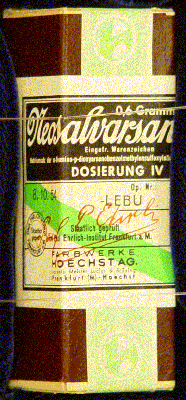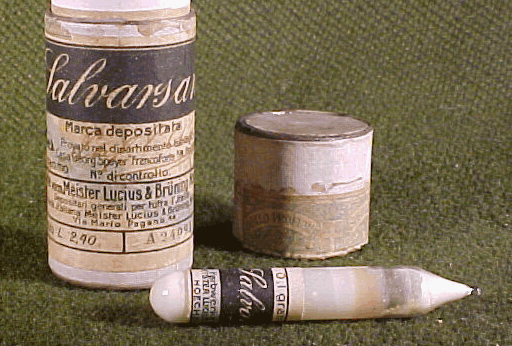|
|
| Ehrlich´s fight against Syphilis | |
| 1872-1878,
Paul Ehrlich's interest in colours and dyes was triggered during his years
of study by the anatomist Wilhelm von Waldeyer-Haartz. At that time Ehrlich
was already enthusiastic about dying anatomical preparations with Anilin
colours. While he was still a student in Freiburg, he accomplished his
first scientific paper: he had used different dyes for the colouring of
cells and discovered mast cells which were of great importance for later
pharmaceutical research.
|
|
|
1890 Ehrlich observed that his favourite dye, methylene blue, which he fed to animals, would only be deposited at the living ends of the nerves, leaving all other body parts uncoloured. This inspired him to look for dyes that would not only colour tissue but also colour and kill micro organisms - a dream that would absorb him for 15 years from then.
1901 Through Alphonse Laveran's papers (discoverer of the Malaria-Microbes) Paul Ehrlich's attention was directed to Trypanosomes. "Hey! This is an excellent Microbe. It is big for a microbe, easily visible, easy to breed in mice. It kills them proper and always. Where could I find a better microbe than this Trypanosome, to help me find the Magic Bullet which is needed for the therapy? Alas! I wish I could find a dye that would heal o n e mouse, one tiny little mouse." Ehrlich and his assistant Dr. Shiga test about 500 dyes for their immunising effect and their utility to battle trypanosomes. Their mice turn either blue or yellow from the dyes, but would not be healed from the Trypanosomes. 1903 One
of Paul Ehrlich's many ideas finally lead to a first result. He assumed
that his dyes are not dissolved and distributed sufficiently in blood,
so he ordered to change the structure of one of his dyes: "[...]
for example add something sulphurous so the stuff is better soluble
within the mice's blood." The new dye initially heals the mice
from the trypanosomes and Ehrlich calls it trypan red. However it soon
turned out that trypan red could not kill all types of Prypanosomes.
But his first success incited him even more and he increased his efforts
to find an effective Magic Bullet to cure millions of suffering patients.
1907 In a chemistry-journal
Ehrlich reads about an arsenical substance called Atoxyl which has been
almost successfully used against the sleeping sickness (which is caused
by a specific type of trypanosomes). "I'm going to modify it slightly"
Ehrlich said to himself, ignoring the warnings of the manufacturers
that Atoxyl would decompose if modified, however slightly. Ehrlich however
manages to modify Atoxyl and thus provides the basis for the creation
of many other arsenic compounds. 1910 Ehrlich achieved a breakthrough with compound 606. The yellow substance which Ehrlich called Salvarsan was an effective and reliable agent against Trypanosomes. Its usefulness for human patients had yet to be proved, though. On August 31st, Ehrlich used compound 606 on Spirochaeta, the virus that causes Syphilis - and compound 606 took effect! This was Ehrlich's field day. After 15 years of research he had discovered his Magic Bullet.
1910 Beginning of chemotherapeutic
treatment with Salvarsan
For a deeper look into Paul Ehrlich´s research: Prüll, Cay-Rüdiger: "Part of a Scientific Master Plan? Paul Ehrlich and the Origins of his Receptor Concept"; Medical History, 2003, 47: 332-356
|





